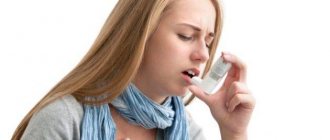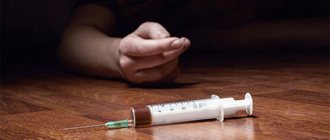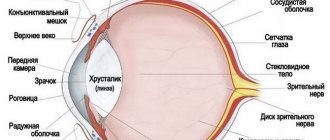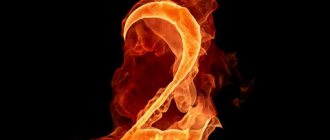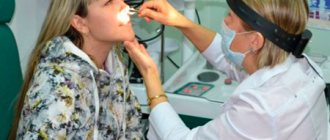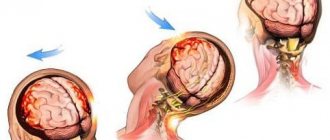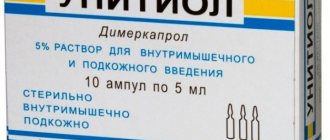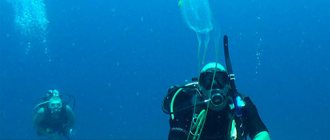Some children have a special reaction to elevated temperature - convulsions. Unprepared parents who find themselves in a similar situation may become confused and even panic. Why does a child have seizures and how to act correctly in critical circumstances? We will look at the causes of spasms in a baby and give step-by-step instructions for mothers and fathers who have had to deal with this phenomenon.
Some children react to high temperatures with seizures
Causes of seizures
First, it’s worth understanding why seizures occur in a child when he has a fever. It turns out that this phenomenon is not uncommon, it occurs in every twentieth child under the age of 5-6 years. As a rule, seizures, which are called febrile, occur due to an increase in temperature from 38.5˚C and above. Very rarely, such spasms accompany a temperature of up to 38˚C. Sometimes even a common cold, as well as a sore throat, flu, reaction to a vaccination, or an increase in temperature during teething can trigger convulsions (see also: temperature during teething in children).
Experts to this day have not been able to give an exact answer to the question of what is the cause of spasms. One of the supposed factors is imperfection of the nervous system, another is genetic predisposition. According to some studies, seizures are more likely to occur in children whose parents showed similar symptoms in infancy. Also at risk are children whose relatives suffer from epileptic seizures.
Decreased calcium levels in the blood can also lead to cramping. In this case, accompanying phenomena are possible - apnea, bloating. A good doctor, after conducting a series of tests, will be able to immediately suspect a lack of calcium in the blood of a small patient. To confirm the diagnosis, you will need to do a blood test.
Causes
Febrile convulsions in newborns can occur during colds with high fever (above 38.3º), during teething. Sometimes the cause of spasms and convulsions can be overheating of the body. A baby's body cannot independently regulate its temperature until a certain age. Doctors argue about what the true causes of cramps in a child’s leg are. Some are inclined to believe that they occur only in cases of genetic predisposition. If one of the parents suffers from nervous disorders or chronic vascular diseases, then the risk of seizures in the baby is increased. Others believe that the causes of febrile seizures lie in the child’s imperfect nervous system. With age, this phenomenon, which frightens parents, appears much less frequently.
Seizures in newborns
Separately, it is worth mentioning the phenomenon of convulsions in newborns. They do not necessarily occur as a reaction to a fever:
- Spasms due to birth trauma may indicate hypoxic damage to brain tissue. Such convulsions develop in the first eight hours of a newborn’s life.
- Hypoglycemic spasms. They can occur against the background of low glucose levels in the baby's blood. As a rule, this phenomenon can be observed in the first 48 hours after the birth of the baby.
- Withdrawal syndrome. Mothers who took alcohol or drugs during pregnancy give birth to children who are accustomed to regular doses of the drug. After birth, the baby stops receiving the toxin, which can cause withdrawal symptoms.
There are other causes of seizures in newborns. However, they are most often the result of serious diseases that are diagnosed during pregnancy or at the time of birth of the baby.
Convulsions at high temperatures in children. What to do? Emergency first aid
If a convulsive attack occurs against the background of a high temperature, it may go away on its own, but you must definitely call an ambulance.
Your actions before the doctor arrives:
- It is necessary to free the baby's neck and chest from clothing so that his breathing does not become difficult,
- Then lay him on a barrel on a flat surface, placing something under his head. Ventilate the room. If a child is vomiting, make sure that he does not choke on the vomit.
- If the attack ends before the ambulance arrives, it is urgent to cool the child’s skin , for example, wipe the armpits, groin folds, elbows and knees with a cold damp towel.
- Be sure to give an antipyretic to prevent the attack from happening again.
- Carefully describe the picture of the seizures , when the doctor arrives and examines the child, note the time of the seizures. Mom usually has no time for this. Ask if there is someone nearby to help you with this. To any mom, it seems like cramps that lasted 30 seconds for an eternity...
Children susceptible to febrile convulsions must be constantly monitored during any infectious disease ; they should not be left unattended and their temperature should not be allowed to rise above 37.5 degrees .
What is important for parents to know?
Such children are contraindicated:
- any overheating
- you can't take them to the steam room
- leave in the open sun
- and in a stuffy hot room.
I suggest watching a video from doctors about febrile seizures in children.
Symptoms: general and individual
The onset of seizures may manifest differently in each child, but there are some things that are common to all. As a rule, febrile seizures have standard features:
- during spasms, the baby does not respond to external stimuli;
- convulsions can provoke a change in the color of the skin - pallor or even slight blue discoloration is possible;
- Most often, muscle spasms last 5–15 minutes.
However, in reality, cramps may look different in each case. They often have a different character:
- Tonic - the child stands tall, throws back his head, and his whole body twitches. These types of seizures are more common. As a rule, in this case, the child stretches his legs, presses his arms to his chest, and throws his head back. The twitching is fading in nature and gradually fades away.
- Atonic - in this case, all muscles relax, even the sphincter. In addition, the baby may wet itself. This type of seizure is much less common.
- Local – the muscles of the limbs tense and twitch, or only one part of the body.
During tonic convulsions, the child sits up straight and tenses all the muscles
Treatment and prevention of seizures
A child experiencing regular seizures should visit a pediatrician.
The attending physician will prescribe an examination and, if necessary, give a referral to more specialized specialists, for example, to an orthopedist in case of suspected flat feet. Parents should adjust the baby’s diet by adding foods rich in magnesium and potassium to the diet. These include legumes, carrots, green leafy vegetables, seaweed, bananas and dried apricots. Taking children's vitamin and mineral complexes will also be useful.
Organize the child's sleeping area so that the child sleeps with his legs slightly elevated. To do this, you can place several sofa pillows or a bolster on the edge of the bed. Before going to bed, your baby can have a light foot massage with warming ointment (this should be chosen on the advice of a pediatrician) or take a warm bath.
Of course, if a child experiences great physical stress on his legs while playing sports, the intensity of training will have to be reduced for some time. In general, cramps will not bother the baby for long when family members notice and promptly begin to solve this problem.
How dangerous are frequent leg cramps in a child, what to do if a cramp severely cramps the calf muscles, thigh muscles, what are the main causes of chronic convulsive attacks in children. Children feel cramps with constant fatigue, lack of sleep, and poor diet. Seizures also appear in seriously ill babies.
Febrile seizures are the most common type of seizure in children. When a child feels a significant increase in temperature (up to 39 degrees) or a drop (during the process of recovery from illness), mothers hear complaints about cramps quite often. This applies to children under 5 years of age. With the help of convulsions, the brain reacts to a change in the state of the body, intoxication with the onset of influenza, pneumonia, sore throat, and gastrointestinal problems.
There are other types of convulsions, which parents call rolling. Occurs in children aged 6-36 months. When a baby cries at a high pitch, there is a lack of oxygen and the baby turns blue, stretches out the whole body, and freezes. Half a minute passes and the baby resumes breathing, the skin becomes pink, and the child is not in a good mood for a long time. A spasm of the glottis occurs, and as a result, oxygen starvation of the brain.
To minimize the occurrence of cramps, create a calm atmosphere at home. The doctor will prescribe mild sedatives and herbs, and after a while everyone will forget that the child was once bothered by seizures. Everything will be alright.
The cause of leg cramps in a child may be an uncomfortable temperature for the body at night or the heaviness of the blanket. Try wrapping your baby's legs before bed, or uncovering them. The cramps should stop. It is also good to stand on a leg that is suffering from a cramp.
All types of seizures discussed above do not indicate the existence of serious health problems. But when chronic leg cramps are observed, which appear regardless of the time of day, be sure to consult a doctor; your baby may have a deficiency of vitamin D and calcium.
Muscle pain during the period of active growth is another common problem that affects the appearance of leg cramps. Ideally, growth should not be painful, but this phenomenon does occur. At the junctions of bones and tendons, the latter become tense due to constant stress, and pain appears. Intensifies at night. Appears suddenly and disappears as well. It is not strong and the child can calmly continue the action being performed.
We looked at the reasons why children may experience frequent leg cramps. As a rule, such cramps of the calf or thigh muscles are caused by a period of intensive growth and development of the child. Below we will discuss in more detail what non-epileptic and epileptic seizures are and consider the reasons for their possible occurrence.
Next article: Thyrotoxicosis. How to treat the thyroid gland
Go back to main page
INTERESTING FOR WOMEN:
Diagnosis and consequences
Experts believe that febrile seizures in children under six years of age will not affect their future health. Most often, the child outgrows this nuisance and by school age can tolerate elevated temperatures without problems. According to neurologists, the children's brain has high potential and recovers quite quickly from oxygen starvation, which provokes convulsions.
However, seizures can transform into epilepsy, which happens only in two out of a hundred cases. It is extremely important that a child prone to convulsions be seen by a neurologist. The doctor will give recommendations to parents and help stop the development of undesirable consequences. However, even if the doctor is sure that febrile seizures are occurring, it is better if the child undergoes a series of examinations. It usually includes:
- general blood test for calcium and glucose levels;
- general urine test;
- computed tomography of the brain;
- stool analysis for worm eggs.
Sometimes additional examinations are required - electroencephalography of the brain or specific tests. Your pediatrician may also recommend consulting a vascular surgeon. All this will give a complete picture of the disease and help the doctor eliminate the possibility of any serious disorders.
Causes of febrile seizures in children
This condition is a type of nervous disorder that occurs when there is a high temperature. Febrile convulsions in a child can have varying degrees of severity - from wringing of hands and rolling of eyes to full-fledged convulsive spasms ending in loss of consciousness. The duration of this state takes approximately a quarter of an hour, but may be shorter. It is noteworthy that it is not always the case that a child who has experienced febrile convulsions will cry during and after they end.
- Doctors say that this symptom can accompany absolutely any disease that is characterized by fever - i.e. increase in body temperature to 38.1 degrees and above. However, it is possible that they may experience seizures even at lower temperatures.
Despite the fact that febrile seizures are not a “young disease,” experts have still not been able to determine the exact reasons for their occurrence. It is likely that genetic predisposition plays a role, since there is often a connection between the fact that parents and other relatives have a history of this diagnosis, and the fact that the baby experiences convulsive spasms when the temperature rises. It was even possible to identify the genes responsible for the transmission of this disorder, but even in their absence, the occurrence of febrile seizures cannot be ruled out.
Conventionally, doctors divide the prerequisites for this condition into 2 simple categories:
- Infectious. Accordingly, this includes diseases whose source is an infection - respiratory, rotavirus, neurogenic, etc. The causative agent can be any pathogenic microorganism - from a virus to a protozoan microorganism or fungus. In infants, the main “provocateur” is often the herpes virus.
- Non-infectious. In this group, there are predominantly inflammatory processes, as well as cases of fever without diseases (excluding hematological ones). In particular, doctors emphasize that non-infectious preconditions for febrile seizures may include pathologies of the nervous system, heat stroke, vaccinations, drug therapy, problems with the endocrine system, teething, pain of various etiologies, and mental disorders.
Mostly this symptom occurs in babies who have reached the age of six months, and can occur in children until they are 4-5 years old. Throughout this time, the formation of the brain occurs, in which excitation processes are predominantly active. The occurrence of these seizures in children over 6 years of age often indicates epilepsy.
- Often, febrile convulsions in children begin on the first day after the temperature rises, i.e. during the so-called period of acute disease. The chances of them happening again 24 hours later are extremely low. The probability of this condition occurring in children is 3%.
- At hyperpyretic temperature, i.e. above 41.1 degrees, febrile seizures are rare.
It is noteworthy that such serious diseases as meningitis or pneumonia, although they are infectious in nature, provoke febrile convulsions extremely rarely. To a greater extent, these symptoms are related to simple and common epidemiological diseases - acute respiratory infections, acute respiratory viral infections, ENT diseases.
What should you be wary of?
Seizures associated with fever are most likely febrile and do not require treatment. There are other, not so harmless causes of convulsions during fever:
- Infections that affect the brain – such as tetanus. Today this disease is very rare because most children are vaccinated.
- Drug poisoning. If a child has swallowed something from a home medicine cabinet - antidepressants or antipsychotics, the medicine may well produce a similar reaction.
- Poisoning by mushrooms or plants.
- Dehydration due to prolonged diarrhea and vomiting.
Helping your child with seizures
Introduction
Cramps are sudden, involuntary attacks of muscle contractions, often accompanied by loss of consciousness.
The appearance of seizures is an indication to immediately call an ambulance. The causes of seizures can be different:
- infections - meningitis, encephalitis, brain abscess;
- metabolic disorders - decreased levels of calcium, potassium, magnesium;
- high body temperature;
- epilepsy;
- brain tumors.
Let's consider providing emergency care for the most common convulsive conditions in children: epileptic seizures, convulsions due to a rise in temperature and convulsions that occur when a child cries.
Epileptic seizure
Epilepsy is a chronic disease accompanied by disorders of consciousness and seizures.
A few hours or days before the onset of seizures, you may notice motor restlessness, labile mood, increased irritability, and sleep disturbances in the child.
The attack classically begins in a child with a cry (initial cry), followed by loss of consciousness (often to coma) and convulsions. The first phase of convulsions lasts 10-20 s and is characterized by tension in the facial muscles and extensors of the limbs; muscles of the body, the jaws are tightly clenched, the eyeballs deviate upward and to the side. The complexion is initially pale, later becoming reddish-cyanotic. The pupils are wide. There is no breathing. The second phase lasts from 30 seconds to several minutes and is manifested by short contractions of various muscle groups of the body. In both phases of the convulsive syndrome, biting of the tongue and lips may occur.
Subsequently, the convulsions gradually decrease, the muscles relax, breathing is restored, the patient is motionless, and urine and feces often pass out. After 15-30 minutes, sleep sets in or the child regains consciousness, completely forgetting the seizure.
First aid for a child with such convulsions
- Place the patient on a flat surface (the floor) and place a pillow or cushion under the head; turn your head to the side and provide access to fresh air.
- Restore airway patency: clear the oral cavity of mucus, insert a small and fairly soft object between the teeth to prevent biting the tongue, lips and damage to the teeth. It is best to tie the edge of a towel or scarf (any other fabric) into a knot and place this knot between the teeth. Using hard objects (such as a spoon) for this purpose can result in broken teeth.
- Hospitalization after emergency care in a hospital with a neurological department. In the future, selection or correction of epilepsy therapy is necessary.
Convulsions due to rising temperature
Convulsions occur when body temperature rises above 38 ºС during an infectious disease (acute respiratory diseases, influenza, otitis media, pneumonia, etc.).
What is typical for seizures due to fever?
Usually, convulsions are observed at a height of temperature and stop when it drops; they do not last long - from several seconds to several minutes; in addition, the child may lose consciousness.
First aid for a child with this type of seizure
- Lay the patient down, turn his head to the side, provide access to fresh air; restore breathing: clear the mouth and throat of mucus.
- Carry out antipyretic measures. If the child has a pronounced fever, that is, the skin is hot to the touch and has a reddish tint, then you can use:
- blowing with a fan (with caution);
- a cool, wet bandage on the forehead;
- cold on the area of large vessels (armpits, groin area);
- carry out wiping - 40% alcohol, 9% (!) table vinegar, water mixed in equal volumes (1:1:1). You can simply use alcohol with water or 9% vinegar with water in equal parts. Wipe with a cotton swab soaked in this solution (except for the face, nipples, genitals), then allow the child to dry; repeat 2-3 times.
Take paracetamol (acetaminophen, Panadol, Calpol) at a dose of 10-15 mg/kg of the child’s weight at a time or ibuprofen 5-10 mg/kg of weight (for children over 1 year old).
If a child has a background of elevated temperature: pale skin, a bluish tint to the lips and nails, cold palms and feet, chills, then wiping and other cooling measures cannot be carried out. It is necessary to warm the child and, against the background of antipyretic therapy, give no-shpa or papaverine at a dose of 1 mg/kg body weight orally (to dilate blood vessels).
An ambulance needs to be called.
Convulsions that occur when a baby cries
These convulsions are typical in the development of children of the first year of life and up to 3 years of age with increased nervous excitability.
What is characteristic of these seizures?
Convulsions are usually triggered by fear, anger, severe pain, joy, or force-feeding a child. During crying or screaming, the breath is held while inhaling, and a bluish tint appears on the skin and mucous membranes of the mouth. Due to the developing lack of oxygen, short-term loss of consciousness and convulsions are possible.
Emergency care for children with such seizures
- Create a calm environment around the child.
Take measures to restore breathing - pat your cheeks; splash your face with cold water; let the vapor of ammonia breathe in (moisten a cotton swab) from a distance of 10 cm.
How to help?
As soon as parents determine that their child is having febrile seizures, they need to act immediately. The right decision is to call an ambulance. However, until a doctor is nearby, it is important not to make the situation worse. It will not be possible to stop the process, but parents are quite capable of trying to avoid the consequences:
- It is necessary for the baby to lie on his back on something hard, and not on a soft feather bed. Make sure that your head is in line with your body and that there is a folded blanket under your neck.
- Try to cool the patient down in order to bring down the temperature a little (for more details, see the article: How to bring down a child’s temperature to 38˚C at home?). Open a window or window, unfasten the clothes around the baby’s neck and chest.
- Control breathing - if the baby holds inhalation and exhalation, artificial respiration is allowed, but only after an attack.
- Make sure that the child does not choke on vomit. If your baby has a gag reflex, you should turn him on his side.
- Remove toys and other objects that a child could get caught on and injure themselves.
As a rule, after five minutes (sometimes a little more), the spasms stop and the child comes to his senses. Now you can bring down the temperature with the help of medications so that convulsions do not recur. You can give antipyretic syrup or use suppositories.
Neurologists recommend noting the time of the beginning and end of the attack, as well as paying attention to and tracking what was a harbinger of seizures. This information will not interfere with the doctor during diagnosis.
First aid
The baby must be examined by a doctor. You need to call an ambulance. Before arriving, try to alleviate the child’s condition. Parents should do the following:
- Do not leave the baby unattended;
- Place on the back and turn the head so that the child does not choke in case of vomiting.
- Create coolness around the child's body.
- Remove clothing.
- Try to light candles to reduce the temperature.
- You cannot give water or tablets.
- You can wipe the child's body with a damp cloth soaked in a slightly acidic solution. A teaspoon of vinegar essence per glass of water is enough.
- During an attack, breathing may stop and artificial assistance must be given.
Febrile seizures in children are not a complex disease. Treatment is required only in cases of constant recurrence at high temperatures. It is important to prevent the occurrence of convulsive conditions. Therefore, it is recommended not to wait for the baby’s body temperature to rise above 37.5-38 degrees.
What can't you do?
Under no circumstances should you give in to panic. Mom must act calmly and thoughtfully. It is worth understanding that convulsions during fever are a fairly common phenomenon; an ambulance doctor will provide the child with the necessary assistance. The main thing is to wait for the doctor and make sure that the child is in the correct position. Do not make unnecessary noise or turn on bright lights. There is also no need to move the patient; it is better to try to arrange a comfortable place where he had a seizure.
You should not try to open the baby’s teeth with a spoon or other object, or try to immobilize him. Some parents try to pour medicine into the mouth to bring down the temperature - this is strictly prohibited. The child may choke on the liquid. In this situation, it is recommended to use rectal suppositories to reduce the temperature. However, it is still better to wait until the convulsions end and only then give medications.
For seizures, it is better to use antipyretic suppositories
What should you not do if you have febrile seizures?
During convulsions, you should not introduce any objects into the child’s mouth , or try to force him to reach his tongue. When manipulating the position of the oral cavity, severe injuries can occur, which negatively affects the condition of the jaws, tongue and teeth. There is also a possibility that part of an object placed in the mouth may enter the respiratory tract, which poses a threat to the child’s life.
The child's movements must not be impeded, especially if there is no risk of injury. When restraining the child’s actions, the parent will not be able to stop or reduce the intensity of the attack, and will also not be able to provide any assistance to the child.
Artificial respiration should not be performed even if it is temporarily stopped or during a long period of febrile convulsions, in which the child is motionless. Until the patient fully regains consciousness, the patient should not be given anything to drink or take medications, as there is a possibility of them getting into the respiratory tract.
First aid for seizures accompanied by high fever
Don't forget about the baby's heat. Hyperthermia also requires competent and quick first aid:
- Undress the baby.
- Ensure the room is ventilated. Reduce the air temperature in the room by all means.
- Give your baby an antipyretic drug. The most preferable in this situation are suppositories containing paracetamol.
Use any method to reduce body temperature. These can be alcohol, vinegar, water rubbing, fanning. You can apply cold to the femoral or carotid artery.


